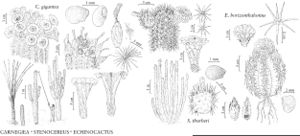Carnegiea
J. New York Bot. Gard. 9: 187, fig. 32, plates 48–52. 1908.
| Taxon | Illustrator ⠉ | |
|---|---|---|
 | Carnegiea gigantea Stenocereus thurberi Echinocactus horizonthalonius | John Myers John Myers John Myers |
Trees, 1–10-branched or unbranched, massive with trunk, main branches erect or ascending from near midstem of trunk (secondary branches absent except where injured). Roots diffuse. Stems unsegmented, green, columnar, gigantic, 500–1500 × 25–75 cm; bark gray, well developed only near base and over stem wounds; ribs 19–26 or, on young plants, 11–15, broadly triangular in cross-section, rib crests rounded, flat, neither tuberculate nor notched between areoles (slightly raised tubercles on distal stems of old plants); areoles 1 cm apart along ribs, circular, elliptic, or shield-shaped, with dense, tannish white to gray hairs; areolar glands absent; cortex and pith not mucilaginous. Spines (8–) 15–28 (–50) per areole, tannish white to beige or grayish, acicular, rigid, terete, flattened, or angular, hard; radial spines (8–) 15–20 (–50) per areole, flattened against ribs or spreading, 10–20 mm; central spines (0–) 4–7 per areole, diffusely spreading, 30–50 × 10–15 mm. Flowers nocturnal, but remaining open next day, mostly terminal to subterminal on stems (also lateral), from adaxial edges of areoles, funnelform-salverform with short tube, 8.5–14 cm; tepals all strongly reflexed; outer tepals green, 2–2.5 cm, margins whitish, undulate; inner tepals waxy white, 2–3.5 × 1–1.8 cm, margins entire or undulate; ovary tuberculate, minutely scaly; scales triangular, small, axils usually without hairs or spines (sometimes flexible bristlelike spines present); stigma lobes ca. 10, tannish white, ca. 12 mm. Fruits dehiscent by 2 or more vertical splits from apex, dark red, obovoid to ellipsoid, 45–95 × 25–45 mm, apex truncate, occasionally with thin white spines; pulp bright red, sweet; floral remnant persistent. Seeds reddish black, obovoid, 1.5 mm, glossy, smooth; testa cells flat. x = 11.
Distribution
sw United States, nw Mexico
Discussion
Species 1.
On young trunks and major branches, spines are stiff, straight, and acicular, and the central spines are strongly developed. In contrast, on young areoles near the flowering stem tips of old primary and secondary branches, spines are mostly flexible, wiry or bristlelike, curved or twisted radial spines. On the oldest trunks, central spines often are lost, and radial spines appear very numerous as they continue to develop for many years as areoles enlarge.
Lower Taxa
"thin" is not a number.